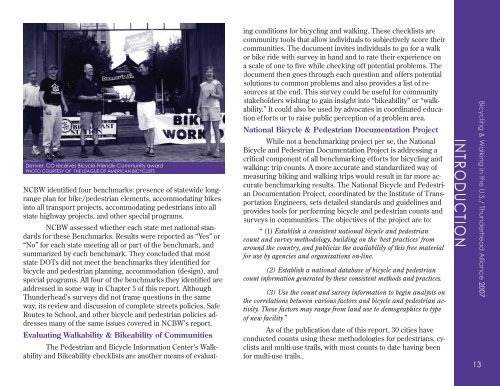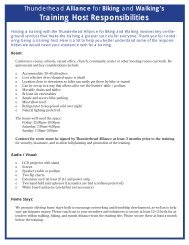2007 Benchmarking Report - Alliance for Biking & Walking
2007 Benchmarking Report - Alliance for Biking & Walking
2007 Benchmarking Report - Alliance for Biking & Walking
Create successful ePaper yourself
Turn your PDF publications into a flip-book with our unique Google optimized e-Paper software.
Denver, CO receives Bicycle-Friendly-Community award<br />
PHOTO COURTESY OF THE LEAGUE OF AMERICAN BICYCLISTS<br />
NCBW identified four benchmarks: presence of statewide longrange<br />
plan <strong>for</strong> bike/pedestrian elements, accommodating bikes<br />
into all transport projects, accommodating pedestrians into all<br />
state highway projects, and other special programs.<br />
NCBW assessed whether each state met national standards<br />
<strong>for</strong> these Benchmarks. Results were reported as “Yes” or<br />
“No” <strong>for</strong> each state meeting all or part of the benchmark, and<br />
summarized by each benchmark. They concluded that most<br />
state DOTs did not meet the benchmarks they identified <strong>for</strong><br />
bicycle and pedestrian planning, accommodation (design), and<br />
special programs. All four of the benchmarks they identified are<br />
addressed in some way in Chapter 5 of this report. Although<br />
Thunderhead’s surveys did not frame questions in the same<br />
way, its review and discussion of complete streets policies, Safe<br />
Routes to School, and other bicycle and pedestrian policies addresses<br />
many of the same issues covered in NCBW’s report.<br />
Evaluating Walkability & Bikeability of Communities<br />
The Pedestrian and Bicycle In<strong>for</strong>mation Center’s Walkability<br />
and Bikeability checklists are another means of evaluating<br />
conditions <strong>for</strong> bicycling and walking. These checklists are<br />
community tools that allow individuals to subjectively score their<br />
communities. The document invites individuals to go <strong>for</strong> a walk<br />
or bike ride with survey in hand and to rate their experience on<br />
a scale of one to five while checking off potential problems. The<br />
document then goes through each question and offers potential<br />
solutions to common problems and also provides a list of resources<br />
at the end. This survey could be useful <strong>for</strong> community<br />
stakeholders wishing to gain insight into “bikeability” or “walkability.”<br />
It could also be used by advocates in coordinated education<br />
ef<strong>for</strong>ts or to raise public perception of a problem area.<br />
National Bicycle & Pedestrian Documentation Project<br />
While not a benchmarking project per se, the National<br />
Bicycle and Pedestrian Documentation Project is addressing a<br />
critical component of all benchmarking ef<strong>for</strong>ts <strong>for</strong> bicycling and<br />
walking: trip counts. A more accurate and standardized way of<br />
measuring biking and walking trips would result in far more accurate<br />
benchmarking results. The National Bicycle and Pedestrian<br />
Documentation Project, coordinated by the Institute of Transportation<br />
Engineers, sets detailed standards and guidelines and<br />
provides tools <strong>for</strong> per<strong>for</strong>ming bicycle and pedestrian counts and<br />
surveys in communities. The objectives of the project are to:<br />
“ (1) Establish a consistent national bicycle and pedestrian<br />
count and survey methodology, building on the ‘best practices’ from<br />
around the country, and publicize the availability of this free material<br />
<strong>for</strong> use by agencies and organizations on-line.<br />
(2) Establish a national database of bicycle and pedestrian<br />
count in<strong>for</strong>mation generated by these consistent methods and practices.<br />
(3) Use the count and survey in<strong>for</strong>mation to begin analysis on<br />
the correlations between various factors and bicycle and pedestrian activity.<br />
These factors may range from land use to demographics to type<br />
of new facility.”<br />
As of the publication date of this report, 30 cities have<br />
conducted counts using these methodologies <strong>for</strong> pedestrians, cyclists<br />
and multi-use trails, with most counts to date having been<br />
<strong>for</strong> multi-use trails..<br />
INTRODUCTION<br />
13<br />
Bicycling & <strong>Walking</strong> in the U.S./ Thunderhead <strong>Alliance</strong> <strong>2007</strong>



